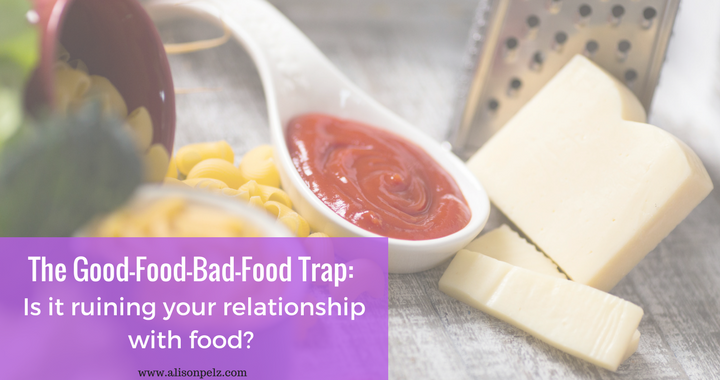I can’t eat that because it is bad for me” or “That is a good food, so I can eat that anytime I want” are examples of the “good-food-bad-food trap.” They are common statements among the general public, and particularly dieters.
The good-food-bad-food trap is just as it sounds—dividing foods into different categories deemed either good to eat or bad to eat. Dieting and public health campaigns really reinforce this all-or-nothing thinking with a series of rules about what we should and should not be eating. While the intention behind this notion is good, it is actually quite problematic in practice.
Why is it a problem?
All-or-nothing-thinking (also called black-and-white thinking) is a mistaken belief that leaves you with only two options, despite there being many gray areas in life. Examples include “I am dumb,” “She hated me,” and “I won’t be able to handle that.” Those who struggle with depression, anxiety, perfectionism, and eating disorders often engage in this line of thinking.
Let’s take a closer look. After yelling at her child, a mother thought to herself, “I am a terrible mother,” which led her to feeling bad about herself. Furthermore, she probably has a million examples of how she is a good mother, such as when she takes care of her child when he is sick and reads him a bedtime story most nights. Instead of thinking “I am a terrible mother,” she could have thought “I wish I hadn’t yelled” or “I am not perfect and sometimes I lose my cool.” With these alternative statements, the stressed-out mom can then problem-solve about why she lost her cool instead of just feeling bad about herself.
Similarly, the good-food-bad-food trap leads to feelings of guilt if a so-called “bad food” is consumed.
First off, there are no magical foods that are all bad or all good. Oftentimes diets determine which foods fall into the good or bad category. If, for example, you are following a gluten-free diet, a piece of wheat bread may be deemed as a bad food. However, that same piece of bread may be deemed a good food on low-fat diet. With fad diets, it feels like the categories of good and bad foods are constantly changing.
Second, are a burger and fries from your favorite fast food joint really bad for you? As I dietitian, I can honestly say that they are not. While they don’t provide tons of vitamins, they do provide much needed fuel for your body. Maybe they even provide a little joy in your life. Doesn’t sound unhealthy to me.
Yes, one could argue that if you ate burgers and fries all of the time, it would be problematic, as your body wouldn’t be getting all its necessary nutrients. And trust me, after your fifth burger in a row, you probably wouldn’t want one anymore thanks to your body’s built-in nifty mechanism that promotes eating a variety of foods.
If you really deem a burger and fries as bad and say that to yourself, you are left with a feeling of guilt, which then makes you feel bad about yourself, then leading you to problematic behaviors. Perhaps you “make up” for eating the burger and fries by over-exercising or restricting your food intake at the next meal. Then the cycle repeats itself over and over again and makes you feel more hopeless or down on yourself. All because of that one distorted thought.
How to get out of the good-food-bad-food cycle:
- Notice your thoughts. What do you say to yourself about what and how you eat?
- If you do use all-or-nothing-thinking with foods, begin to challenge the thinking by asking “Is there a more realistic way I could think about this? What would I say to a friend about this thought? Can I be more descriptive rather than judgmental?”
- Practice changing your thought to a more realistic and accurate one.
Here is an example:
1. Notice the thought. After eating an ice cream cone, you say, “Oh gosh, that was bad. I shouldn’t have eaten that. It wasn’t on my diet.” You may have feelings of guilt and become preoccupied with eating the ice cream cone. Perhaps you start to feel a little hopeless and even berate yourself. Maybe it even leads to your thinking “Well I already blew it,” and then you go on to overeat.
2. Challenge the thought with more accurate and realist thinking. “I really enjoyed that ice cream. I haven’t had it in a while. I should remember to eat some of my favorite foods.” Or “One ice cream isn’t going to change my body. Ice cream can be a part of a healthy diet.” Or “I wasn’t planning on eating that, but I did enjoy it.” Or “I would like to learn how to eat ice cream and not feel bad about it.”
Notice after you challenge the thought, your feelings of guilt may lessen. Save the guilt for when you have really broken a moral rule.
Challenging the good-food-bad-food trap takes time and lots of practice. Remember the first step is to notice what you are saying to yourself about your eating. Then change the thought to a more realistic one, which will lessen the guilt or shame, which will begin to shape positive behaviors that you want.
If you live in the Austin area, please call for a free 15-minute phone consultation at (512) 293-5770.


